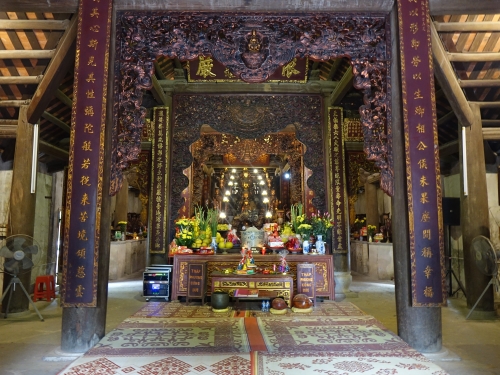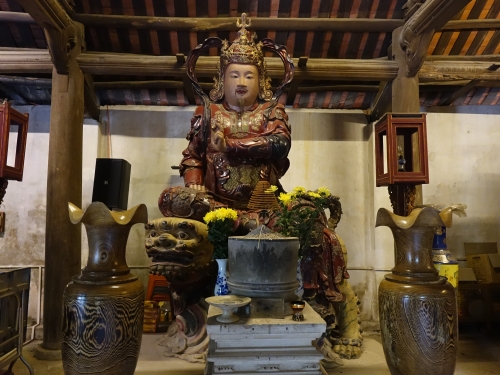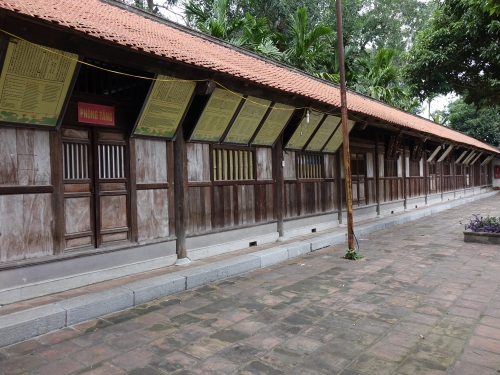Blog TWHS Visits
Yen Tu: Vinh Nghiem Pagoda
Vietnam’s next scheduled nominations will probably be Cat Ba first (extension of Ha Long Bay) and Yen Tu thereafter. 'The Complex of Yen Tu Monuments and Landscape' is a mixed site that comprises a huge area, spread out over 3 separate regions. It is the heartland of Truc Lam Zen Buddhism. One of its components is the so-called Perfume Pagoda, a popular day tour from Hanoi. I wanted to opt for a less touristy destination though. Skimming the long description of this TWHS, the Vinh Nghiem pagoda stood out to me as probably the most worthwhile individual component.

The Vinh Nghiem pagoda dates back to the beginning of the 11th century and was enlarged during the Tran dynasty (from the 12th century on), when it became the center of Truc Lam Zen Buddhism. Truc Lam ("bamboo forest") is the only indigenous form of Buddhism in Vietnam. The Vinh Nghiem pagoda was also the first training institute in Vietnam to teach Buddhist monks and nuns. This pagoda lies near the provincial capital of Bac Giang and within a reasonable bus distance from Hanoi.
So on a gloomy New Year's Day I first went with city bus 34 to Hanoi’s long distance bus station My Dinh and there caught one of the half-hourly buses to Bac Giang. The Vinh Nghiem pagoda lies in the village of Tri Yen, some 18km outside of Bac Giang. I had an idea how to get there (take a taxi), but not what to expect of it. Would it be big or small? Would it be open to tourists at all? And an important lesson from previous visits to remote (future) WHS: would I be able to find transport back?
The pagoda turned out to be on the edge of the village of Tri Yen. It looked deserted, but all gates were open. I walked through the large wooden doors into the first big hall of the pagoda. Wow! I knew immediately that it had been a good decision to come here. What an impressive collection of statues of Buddha and arhats. It has a central altar that goes deep into the back of the temple - it seems infinite. Also behind this are rows and rows of statues.

The religious complex of the pagoda consists of four original wooden buildings in a row, including a bell tower. Around it are outbuildings that are still inhabited. There is also a garden. To the left of the temples there is a storehouse which holds more than 3000 ancient woodblocks for printing. These contain early Buddhist writings in Chinese and Nom (Vietnamese written with Chinese characters). A bit similar to the Tripitaka Koreana at Haeinsa, but they are so special that they are already on another UNESCO list: the 'Memory of the World' register.

I did not encounter anyone during my entire visit. However, music played softly in the background all the time and I found two not too vigilant dogs at the back of the pagoda complex. Afterwards I was prepared to walk the 6km to the main road to catch transport back to Bac Giang and then Hanoi, but already just outside Tri Yen village I stumbled upon a growing group of people waiting for a bus. That bus (arriving at 2pm) turned out to be a big coach. Soon it became clear why: in every hamlet, on every street corner, students were waiting to go back to school or university after the free long weekend. The bus sign said ‘Bac Giang’ but when it turned onto the Bac Giang – Hanoi Expressway I knew that it was going to Hanoi straight away. It was again a lucky escape for me from a remote (T)WHS.
Els - 5 January 2019
Comments
Kyle Magnuson 6 January 2019
One wonders if Vinh Nghiem Pagoda could not be inscribed alone, much like Haeinsa Temple? Or perhaps with a smaller collection of components. Yen Tu seems to be following the route of Trang An. The Advisory Bodies did not seem fully on-board the first time, I expect a similar conclusion, perhaps still ending with an inscription.
Zoë Sheng 6 January 2019
Sounds better than a trip to the Perfume Pagoda!!
Els Slots 4 January 2019
Unfortunately I think this is the best location among the many of this TWHS. It is a very unfocused nomination. There are natural components as well (waterfalls, sacred mountains) but the landscape near this pagoda was typical rural Vietnam - flat with rice paddies.
Kyle Magnuson 4 January 2019
Wow! This sounds like a place deserving of world heritage status. I hope all components are as noteworthy and the dossier is completed to the Advisory bodies satisfaction.